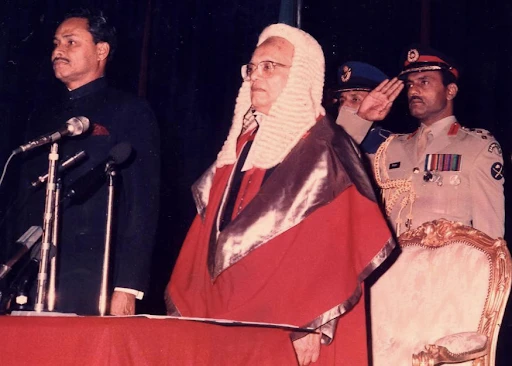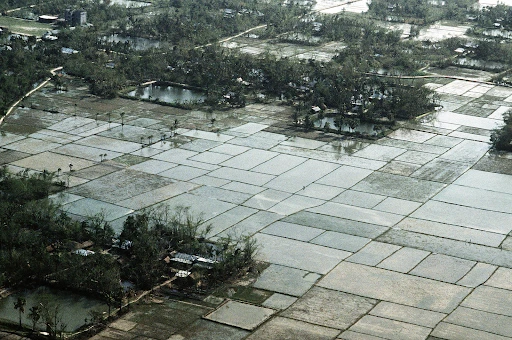Most Americans know the Gulf War for the successful rout of Iraqi forces from Kuwait, but there’s an important side story to this history: a navy flotilla, while on its way back home after the ceasefire, helped save Bangladesh from collapse after the 1991 Bangladesh Cyclone. Dubbed “Operation Sea Angel,” eight thousand navy personnel and marines helped provide critical disaster relief to a country that had sustained over $1.7 billion in damages.
The 1991 Bangladesh Cyclone was the most deadly cyclone on record up to that time. Its strength equalled a Category 5 with gusts approaching two hundred miles per hour. The estimated death toll from the storm surge and flooding was 138,866—most occurring within the first hour that the storm made landfall. Somewhere between 2–3 million people fled the coast and offshore islands before the storm hit; and without significant disaster response infrastructure, much of the country was unreachable by normal aid partners, such as the U.S. Agency for International Development (USAID) or NGOs. At the time, the USAID mission was also severely understaffed due to a voluntary evacuation that occurred as a result of the 1991 Gulf War. Shortly after the storm had receded, U.S. Ambassador to Bangladesh William Milam appealed to Washington for military support in responding to the disaster. A Marine Expeditionary Force was dispatched from Okinawa and played a major role in the disaster response in Chittagong, the country’s second-largest city.
That same week, a flotilla of U.S. navy ships was crossing south at the entrance of the Bay of Bengal on its way home from the Gulf War. Ambassador Milam was able to request their support, and within days over eight thousand navy personnel and special forces had landed in Bangladesh. Over the next six weeks, U.S. military personnel assisted in burying the dead, accessing remote locations unreachable to USAID or NGOs, restoring communications, and providing food aid.

The operation, under the command of Major General Henry Stackpole was named “Operation Sea Angel,” and is one of the largest military relief efforts ever carried out.
Frank Young was the program officer and disaster relief officer for USAID in Bangladesh from 1988–1994 and was involved in several different development projects. He recounts here the dramatic impact the U.S. Navy and Marines had in the response to the 1991 cyclone, as well as an emotional farewell at the end of the operation. Mr. Young was interviewed by John Pielemeier on May 4, 2022.
Read Frank Young’s full oral history HERE.
Drafted by Calvin Heit
ADST relies on the generous support of our members and readers like you. Please support our efforts to continue capturing, preserving, and sharing the experiences of America’s diplomats.
“We couldn’t mount a response because we’d never seen anything like this in our lives.”
Disaster Strikes:

We went through martial law, starting in October of 1990. Then we had the Gulf War in January of ’91 (during which) we had the partial evacuation of the mission. We had the Bangladeshi elections in February 1991 because the military had overthrown President Ershad the prior Fall, which is what ushered in martial law. Begum Zia [Khaleda Zia] was elected president. And then we had the great cyclone of 1991 on April 30.
And all of those events together probably created the greatest kaleidoscope of stress and, I don’t know, productivity that I’d ever experienced. I think a lot of us came out of that whole series of events with some PTSD because of the things we saw and the pressure we were under. And I’ll end with this, the penultimate act was when, after the cyclone hit, the next day, we were trying to organize response teams down in Bangladesh. We were cut off from the rest of the world, by the way; Washington couldn’t get in touch with us. I mean, it was down. They could get flash messages through, I think, but phone calls were impossible, and the Internet and the emails were up and down. We couldn’t do it. We couldn’t mount a response because we’d never seen anything like this in our lives.
“They probably rescued a country. They certainly rescued a democracy.”
Here Comes the Navy:
So, the U.S. military was bringing a flotilla of Navy ships and Navy Corpsmen back from the Gulf War, and they were on their way to San Diego. And Ambassador Bill Milam, at the time, his first reaction was, “We gotta get the U.S. military in here.” The NGOs reacted very negatively. The AID mission, myself included, and Mary [Kilgour, Mission Director], we all reacted very, very negatively. We didn’t want the military on the ground, we thought it would be a bad move politically. The political section did not agree, obviously. The U.S. Marines up in Okinawa, we put in a call to them and they sent down a Marine Expeditionary Force to start the process of organizing communications and logistics and begin to set the stage for being able to ferry relief supplies in and out of Chittagong. They actually took over the air traffic control system in Chittagong. At the same time that this navy flotilla was passing just south of the Bay of Bengal, Ambassador Milam made the call to the White House and said, “We want them.” They made a steep left turn, came straight up the Bay of Bengal and docked the entire flotilla of ships, helicopter carriers, supply ships, I think it was about 8000 naval personnel and special forces. They’re on those ships, and they leapt into action, and in the next six weeks, they probably rescued a country. They certainly rescued a democracy.
The Marine General, General Hank Stackpole, when he was getting some resistance from the Bangladeshis, he did what we couldn’t do. He went in to the Prime Minister and said, “This is your disaster, this is your response. But if you don’t start giving the civilians some authority to handle this, and if you don’t take this over, and start issuing orders, not allowing the military just to do it—the Bangladeshi military—and getting the communication structure set up and all of that,” he said, “we’re leaving, you don’t need us.” And they [the Bangladesh government] immediately did a 180 and did everything the Marines asked them to do. They gave permission for the Navy and the Special Forces to come on shore.
Their first task was to bring white sheets and bury people, and they buried thousands of people. Their second task was to send special forces into areas that we could not access, that our NGO staff, even Bangladeshi staff, could not access, because the special forces troops were self-contained, self-supplied. They got back in there and gave us intelligence on conditions that we would never have gotten otherwise, which allowed us to organize and target our assistance to the places where it was badly needed.
“We took to the sea to kill people and break things. We didn’t fire a shot in anger our whole time during the Gulf War. And yet, we used everything we had on the ships to save lives and help rebuild a country.”
A Teary Farewell:
Fast forward to six weeks later when they’re getting ready to leave, and they make an offer to those of us who had been on the mission disaster response team. Myself, Jose Garzon, and Olivier Carduner. They flew us on a helicopter out to the Tarawa, the USS Tarawa. This is where it gets a little hard, John. We landed on the Tarawa, and they met us with jackets, USS Tarawa jackets, and we went down and we had lunch with the men and women from this naval task force. And one of them got up and said, “You know, we took to the sea to kill people and break things. And we didn’t fire a shot in anger our whole time during the Gulf War. And yet, we used everything we had on the ships to save lives and help rebuild a country.” And they were in tears. And we were in tears.
“But I think thanks to that, Bangladesh bounced back stronger than ever.”
Aid Workers as Heroes:
We wrote this up. It was written up as Operation Sea Angel. It’s still known as that today. The after action report for it, which I helped write, is classified and held at National Defense University, and when I was teaching there, I was not allowed to see it. The irony! But as I say, that event was at the end of so many other events before it, was so traumatic that even now, bringing it to memory brings tears to your eyes.

Not just because of the horror of the experience, but of the heroism of our military, the NGOs, the Bangladeshi staff, our American AID staff, who—at some risk to their lives—traveled down there. There was a lot that that staff endured, in all segments of the response, whether it’s American, Bangladeshi, military, civilian. I mean, there were thousands of heroes in that response whose story will probably never be written. But I think thanks to that, Bangladesh bounced back stronger than ever. Since then it’s experienced enormous cyclones, enormous floods, but its death toll has been far less because of what it learned, and I think because of the intervention that we were able to make at the time. And it was at that time that we came up with a design for the evacuation centers on stilts, in order to cope with, you know, storm surges, and so forth.
TABLE OF CONTENTS HIGHLIGHTS
Education
BA in International Studies, Callison College, University of the Pacific 1968–1972
MA in International Development, Fletcher School of Law & Diplomacy 1972–1973
PhD in International Development, Fletcher School of Law & Diplomacy 1974–1976
MS in National Security Studies, National War College 1995–1996
Joined the Foreign Service 1976
Dhaka, Bangladesh—Program Officer, Deputy Mission Director 1988–1994
Washington, D.C., United States—Director of Management and Planning 1996–1998
Accra, Ghana—Mission Director 1998–2002
Washington, D.C., United States—Deputy Assistant Administrator for Africa 2004–2005
